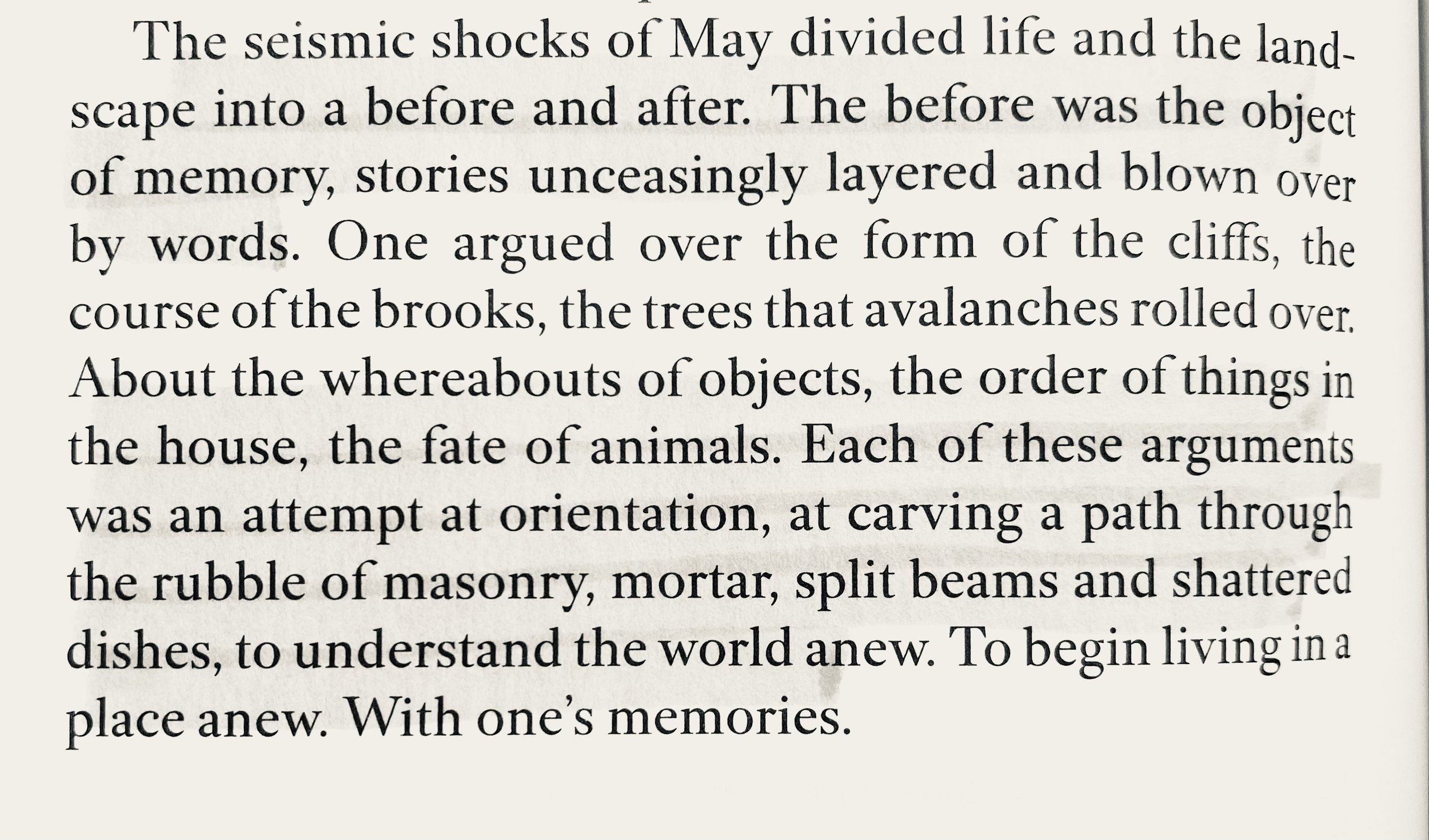This week, I had an interesting (albeit abrupt) exchange with an American female who insisted she had lived in “a village”—- and it was this allusion to personal experience in an American village which she used to dismiss (immediately, unquestionably, and absolutely) my interest in the village-like images of a poem titled “Peasant” from a book titled The Lice.
As I muted myself, the teen walked into the room with wide eyes and asked: “Eeee, who is the person screeching at you from the computer, Mom? She needs to chill out.” He had heard her yelling from the kitchen. I tried not to laugh.
Leaving aside the aspirations of global-villageism wielded by neoliberalism’s finest, turning my attention to a world outside the almighty dollar’s branding of planned communities, Esther Kinsky’s Rombo, translated from the German by Caroline Schmidt (NYRB, March 2023), is a formidable novel about an Italian village destroyed by an earthquake.
Background: Il rombo is an Italian term for the subterranean rumble before an earthquake. In May and September 1976, two severe earthquakes ripped through the Friuli region in northeastern Italy, causing extensive damage. About a thousand people died under the rubble, tens of thousands were left without shelter, and many ended up leaving their homes forever. Rombo is a record of this disaster and its aftermath, as told by seven men and women who were children at the time: Anselmo, Mara, Olga, Gigi, Silvia, Lina, and Toni. They speak of portents that preceded the earthquakes and of the complete disorder that followed, the obliteration of all that was familiar and known by heart. Their memories, like the earth, are subject to rifts and abysses. Esther Kinsky splices these indelible, incomplete recollections with exacting descriptions of the alpine region, forgoing a linear narrative for a deftly layered collage that reaches back and forth in time.
The novel’s author is German. I was intrigued by the references to a Slavic language spoken by the villagers—and to the way certain words (like Babe) also map onto Carpathian mountains in Transylvania.
How can we find a way into a complex story where the landscape is much as much a speaker as the narrators? Many immigrant writers struggle with this relationship between the palpable, subconscious longing (dor) for a particular land and the way in which the land feels like part of the self.
I think Esther Kinsky does this effectively and brilliantly.
Alternating between small encapsulated sections titled after speakers, flora, fauna, geological features, and “found objects” (descriptions of photographs), Kinsky's novel also blurs the line between the geology and the processes which lead to photos that 'preserve' the past. For instance, the sections titled "Corrosion" and "Vapours" describe parts of photochemical development in order to analogize those processes to landscape features in Italy.
The aftermath— first humans help each other, then they begin competing for resources, arguing over explanations, trying to find a way to understand (and control) the earthquake.
The world is divided. The arguments, themselves, occupy a choral form.
How are these village arguments different from the interpretations of poetry? In this novel, the villagers know each other; and the entanglement of their lives means that blame carries consequences, or increases the likelihood of curses.
Using metaphor, analogy, geology, and local lore, Kinsky links geographical changes in the disputed memories and layers of perspective. The landscape is shaped by the humans on its surface, and the humans, in turn, are formed from their relation to the damaged landscape—-these two processes are so deeply intertwined that consequentialist readings can only result in misreading.
Considering the question—What we do know for sure?—-the writer reckons with perspective and point-of-view.
How does the knowledge of the child narrator differ from that of the adult narrator?
How does the child narrator expand the scope of possibility?
The voice that doesn't already know what it wants to say—this is the vulnerable voice, the least defensive one, the space in which the human speaks to the human in all their brokenness.
Back in the 1950’s, in a lesser-known book, Rachel Carson spoke of a “sense of wonder” in relation to childhood, or the possibility of the child’s placement in relation to the world. Granted, she was criticizing the nature of screens and media at a time when she believed television cut off the mind from relating to its environment. Sometimes I sense this hunger for wonder in W. S. Merwin’s poems, or in their efforts to re-enchant the world without the idolizing the powers that govern and destroy it.
I say “destroy”—
Initially, a typo had the prior sentence reading: their efforts to re-enchant the world without the idolizing the powers that govern and destory it. The de-storying of the world is at the heart of the culture industry’s efforts to promote the mental healthy industry. Rather than choose a barricade in this category of the culture wars, I feel more comfortable listening, reading, studying and trying to observe the ways in which money and mental health rubrics mediate the human hunger for meaning in contexts where community is increasingly thin and related to the administration of capitalist markets.
And perhaps, also: to consider the ways language produces outcomes.
To cherish the conversation between Yiyun Li and A. M. Homes in which Homes says:
And to which Yiyun Li responds:
This writer— me— holds Yiyun Li’s words as talismans against the impulses and urges which lead me to believe I could know all villages from having lived in or summered in or visited one. For how could the world not be more complicated and incredible than the Disneyworld of neoliberalism’s global village? What would have to die within us in order to believe that the USA is the expert of the village?



